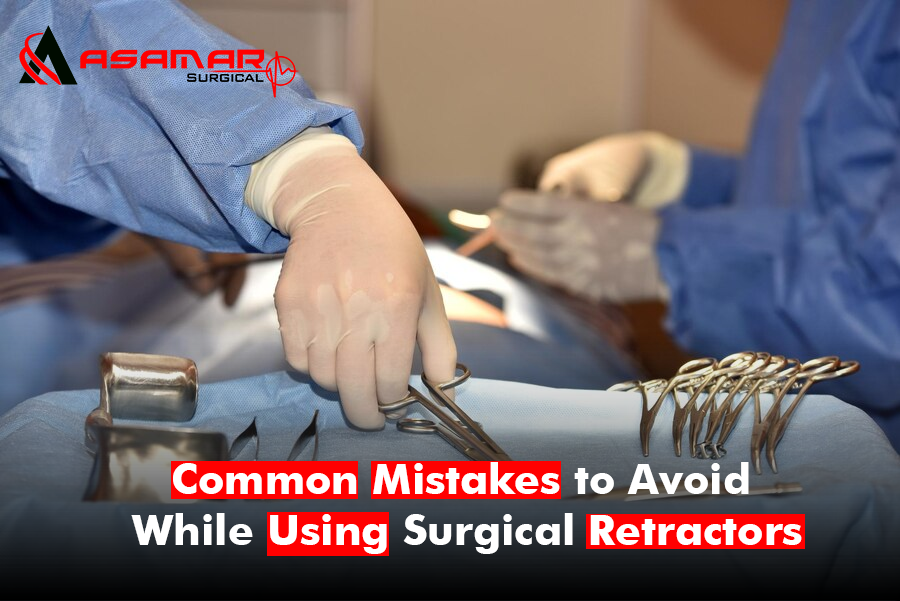A Detailed Guide for Surgeons and Operating Room Professionals
Surgical retractors play a vital role in almost every major surgical procedure. Their purpose is to hold back tissues, muscles, or organs to provide the surgeon with a clear view of and access to the operative field. Despite their essential function, misuse or mishandling of these instruments can lead to intraoperative complications, postoperative issues, and increased risks for the patient.
In this article, we will explore the most common mistakes made while using surgical retractors, supported by clinical understanding, and offer insights into best practices for safer and more effective outcomes.
1. Using the Wrong Type of Retractor for the Procedure
One of the most significant and frequent errors is choosing an inappropriate retractor. Retractors come in various shapes, sizes, and functions—ranging from hand-held to self-retaining models—each designed for specific surgical environments.
Examples:
- Using a McIvor mouth gag in place of a Davis Boyle tongue retractor may limit visibility in oral surgeries.
- Abdominal surgeries often require deeper, wider retractors like the Balfour or Gossett, rather than superficial handheld types.
Best Practice:
Understand the anatomy involved in the procedure and select the retractor best suited to provide optimal exposure without causing unnecessary stress on tissues.
2. Applying Excessive or Uneven Retraction Pressure
Over-retracting tissues can cause crushing injuries, vascular compromise, nerve damage, or even tearing of fragile structures. This often happens when retractors are improperly handled or when the assistant maintains high tension for prolonged periods.
Risks Include:
- Nerve palsy from prolonged compression.
- Muscle ischemia or necrosis.
- Postoperative chronic pain or impaired function.
Best Practice:
Use gentle, progressive force. Train assistants to be attentive to resistance and feedback from the surgeon. Self-retaining retractors should be adjusted to maintain balance between exposure and safety.
3. Prolonged Retraction Without Intermittent Release
Even moderate pressure, if maintained for extended periods, can lead to compromised blood supply and tissue ischemia. Certain tissues are especially vulnerable to pressure-induced damage.
Clinical Impact:
- Delayed wound healing.
- Increased risk of postoperative infection.
- Muscle or organ dysfunction due to sustained compression.
Best Practice:
Schedule short “release intervals” during long procedures. Alternate sides of retraction if possible, especially in symmetrical procedures.
4. Improper Placement and Positioning
Incorrect placement of a retractor can not only obscure the operative field but also lead to iatrogenic injuries. For example, placing a rib spreader incorrectly in thoracic surgery can damage intercostal vessels or nerves.
Consequences:
- Poor visibility and increased surgical time.
- Risk of unintended tissue damage.
- Difficulty in achieving desired surgical goals.
Best Practice:
Retractor placement should be guided by anatomical landmarks. Always reassess the field after placement and adjust if any obstruction or excessive tension is observed.
5. Lack of Team Coordination and Communication
Surgery is a team effort. Many retractors—especially handheld models—require coordination between the surgeon and assistants. Miscommunication can lead to abrupt movements, loss of exposure, or accidental trauma.
Common Scenarios:
- An assistant changing the angle or force without warning.
- Misunderstanding of surgeon’s instructions during critical steps.
Best Practice:
Establish clear verbal cues and maintain consistent communication throughout the procedure. Train assistants to anticipate needs based on surgical flow.
6. Using Low-Quality or Damaged Instruments
A faulty or worn-out retractor can fail during surgery, potentially compromising the procedure and increasing patient risk. Inadequate retraction, mechanical failure, or contamination due to rust or corrosion are all risks.
Inspection Checklist:
- Check for cracks, bends, or loosened joints.
- Ensure smooth functioning of ratchets or locking mechanisms.
- Sterilize as per international standards to prevent contamination.
Best Practice:
Always invest in high-quality surgical instruments from reputable manufacturers. Implement routine inspection and maintenance protocols to extend the life and performance of the instruments.
Conclusion
The effective use of surgical retractors is not just about selecting and placing the tool—it’s a comprehensive practice involving anatomy, technique, communication, and equipment management. Avoiding the common mistakes highlighted in this article can enhance surgical efficiency, reduce operative time, and most importantly, safeguard patient health.
Hospitals, surgical teams, and instrument suppliers must collaborate to ensure that all personnel are trained in the correct use of retractors and that high-quality instruments are used in every procedure.

